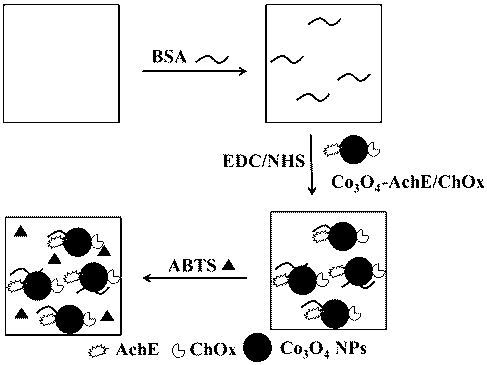Preparation and application of pesticide rapid test card
A rapid test card and pesticide technology, applied in the field of preparation and application of pesticide quick test card, can solve the problems of complex production process and high cost
- Summary
- Abstract
- Description
- Claims
- Application Information
AI Technical Summary
Problems solved by technology
Method used
Image
Examples
Embodiment 1
[0037] The preparation process of composite catalytic material is characterized in that the method comprises the steps:
[0038] (1) Add a certain amount of sodium borohydride to the mixed solution containing BSA and divalent cobalt ions, and obtain Co by the reduction of sodium borohydride and the oxidation of oxygen 3 o 4 NPs, centrifuged and dried to obtain a solid;
[0039] (2) A certain amount of Co 3 o 4 NPs were added to 0.2 mM BOC solution to protect Co 3 o 4 Amino groups on NPs were washed and dried after standing for 2 hours;
[0040] (3) Co obtained in step (2) 3 o 4 NPs were added to the mixed solution of EDC and NHS with a mass concentration of 2% to activate Co 3 o 4 Carboxyl groups on NPs, let stand for 5 hours, wash with water, and dry;
[0041] (4) Co 3 o 4 NPs are added to the mixture of AchE and ChOx, and the amino groups on AchE and ChOx will interact with Co 3 o 4 The carboxyl group on NPs undergoes an amide reaction to immobilize them o...
Embodiment 2
[0043] The preparation process of the quick test card ( figure 1 ):
[0044] (1) Drop the BSA solution with a mass concentration of 1% on the cellulose membrane, let it stand for 1 hour and dry it at room temperature;
[0045] (2) Drop EDC and NHS with a mass concentration of 2% on the cellulose membrane modified with BSA described in step (1) (nitrocellulose membrane with good water absorption) to activate the carboxyl group of BSA, and let stand 5 hours, washed with water and dried at room temperature;
[0046] (3) Evenly drop-coat the solution of the composite catalytic material onto the cellulose membrane obtained in step (2), the amino group on the composite catalytic material will undergo an amide reaction with the carboxyl group on the BSA to fix it on the cellulose membrane, 4 overnight at ℃, washed with water and dried;
[0047] (4) Drop-coat the organic chromogen solution onto the cellulose membrane modified with the composite catalytic material described in step...
Embodiment 3
[0051] Feasibility of quick test card detection:
[0052] Catalyzed reaction system (a) Cut the color chart into pieces and put it in acetylcholine (1 mmol / L) solution (pH=5.0). After reacting for 5 minutes, take the reaction solution for full-wavelength scanning. Do another set of control experiments (b) Cut the colorimetric card into pieces and put them in the buffer solution (pH=5.0), react for 5 minutes and take the reaction solution for full-wavelength scanning.
[0053] Such as image 3 As shown, the catalytic reaction system (a) has an obvious ultraviolet absorption peak, and the catalytic reaction system (b) has no ultraviolet absorption peak, which proves that the catalytic reaction can only be carried out under the condition of the presence of acetylcholine.
PUM
 Login to View More
Login to View More Abstract
Description
Claims
Application Information
 Login to View More
Login to View More - R&D
- Intellectual Property
- Life Sciences
- Materials
- Tech Scout
- Unparalleled Data Quality
- Higher Quality Content
- 60% Fewer Hallucinations
Browse by: Latest US Patents, China's latest patents, Technical Efficacy Thesaurus, Application Domain, Technology Topic, Popular Technical Reports.
© 2025 PatSnap. All rights reserved.Legal|Privacy policy|Modern Slavery Act Transparency Statement|Sitemap|About US| Contact US: help@patsnap.com



